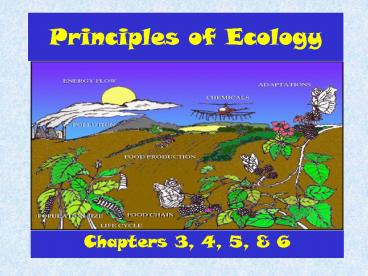Principles of Ecology - PowerPoint PPT Presentation
1 / 15
Title: Principles of Ecology
1
Principles of Ecology
- Chapters 3, 4, 5, 6
2
What is Ecology?
- Ecology is the study of interactions between
organisms and their environment.
3
Components of the Biosphere
- Biosphere portion of the Earth supporting life
- Within the biosphere you
- have the following
- factors
- A. Biotic factors
- All organisms inhabiting the environment
- 2. The living things in the environment!
- B. Abiotic factors
- Nonliving parts of the environment
- Can determine which species will survive
examples rainfall, temperature, light, soil
Rain, Rain Go Away
4
C. Levels of Biological Organization
- 1. Species a group of organisms that can breed
and produce - fertile offspring!
- 2. Populations
- a. A group of organisms of the
- same species living together
- b. Must compete for resources
5
Levels of Biological Organization
- 3. Community
- Several populations that interact
- Changes in one population will cause changes in
the others - 4. Ecosystem
- a. Interactions between populations and their
surroundings - 2 main types
- 1. Terrestrial land
2. Aquatic fresh or salt water
6
D. Niche vs. Habitat
- 1. Niche The role an organism plays in the
environment (Its job in the
community) - Habitat Place where an organism lives
Habitat of the earthworm SOIL Niche To
aerate (break-up) the soil.
7
Types of Feeding Relationships
- Autotrophs a. Self-feeders,
produce their own food
b. Example plants, algae - Heterotrophs a. Depend on other
organisms for food
Herbivore eats only plants Carnivore eats
only meat Omnivore eats both
8
- Decomposers
- a. Break down and absorb nutrients from dead
organisms - b. Example mushrooms, bacteria
bacteria
fungus
mushroom
earthworms
9
4. Symbiosis - close, permanent relationship
between organisms a. Three major types 1.
Commensalism 2. Mutualism 3. Parasitism
2) Friend alga cell is prepared to greet Mr.
Fungus
1) Mr. Fungus is ready to greet our friend the
alga
3) The Lichen is created between the fungus and
the alga
10
1. Commensalism a. Relationship in which one
species benefits and the other is not
affected b. Example remoras that live
on/around a sharks mouth
Remora on a Ray
11
tickbirds
- 2. Mutualism
- a. Both species benefit b. Example tickbirds
eat parasites off of a rhino - 3. Parasitism
- a. One organism benefits and the other
is harmed b. Example tapeworm
living inside a persons intestine
oxpeckers
12
- Energy pyramids show decreasing amounts of
energy, biomass, and number of individuals as you
move up the pyramid
There is no limit to the number of levels that a
food chain can support. Only 10 of the energy
from one level is transferred to organisms at the
next level. The remaining energy is released
into the environment as heat.
13
Food Chains and Food Webs
- Food Chains
- a. Model showing movement of energy
through the ecosystem - b. Uses arrows to show what eats what
Food Chain
Grass ? Cow ? Human
14
- Food Web
- a. More complicated than a food chain
- b. Shows more than one food source for each
organism - c. More realistic view of energy transfer
15
Quiz 1
- Your house is an example of a(n) ___.
- a. biotic factor b. habitat
c. niche - Trees, mosses and shrubs are all examples of what
type of factor? - a. abiotic b. biotic c.
commensalism - The study of interactions between organisms and
their environments is called ? - a. botany b. cytology c.
ecology - If you work at McDonalds, that is an example of
your? - a. habitat b. niche c.
community - A group of deer that live in a forest is an
example of a? - a. biosphere b. community c.
population































